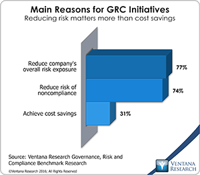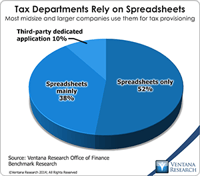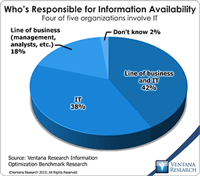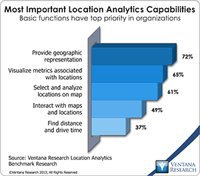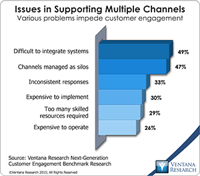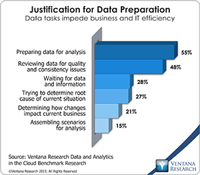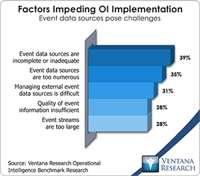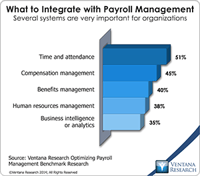Today’s proponents of artificial intelligence (AI) tend to focus on its spectacular uses such as self-driving cars and uplifting ones such as medical treatment. AI also has the potential to aid humanity in more modest ways such as eliminating the need for individuals to do tedious repetitive work in white-collar areas. Along these lines, at its recent Vision users conference, IBM displayed an application of its Watson cognitive computing technology designed to automate important aspects of...
Read More
Topics:
Governance,
Office of Finance,
Business Performance,
Cloud Computing,
Financial Performance,
Uncategorized,
Risk & Compliance (GRC),
GRC, governance, risk, compliance, risk management
The steady march of technology’s ability to handle ever more complicated tasks has been a constant since the beginning of the information age in the 1950s. Initially, computers in business were used to automate simple clerical functions, but as systems have become more capable, information technology has been able to substitute for increasingly higher levels of human skill and experience. A turning point of sorts was reached in the 1990s when ERP, business intelligence and business process...
Read More
Topics:
Sustainability,
ERP,
Governance,
GRC,
Human Capital,
Office of Finance,
audit,
finance transformation,
LongView,
Tax,
Analytics,
Business Analytics,
Business Performance,
Financial Performance,
Oracle,
CFO,
Risk & Compliance (GRC),
Vertex,
FPM,
Innovation Awards,
Thomson-Reuters multinational
IBM redesigned its business intelligence platform, now called IBM Cognos Analytics. Expected to be released by the end of 2015, the new version includes features to help end users model their own data without IT assistance while maintaining the centralized governance and security that the platform already has. Our benchmark research into information optimization shows that simplifying access to information is important to virtually all (97%) participating organizations, but it also finds that...
Read More
Topics:
Big Data,
Mobile Technology,
Wearable Computing,
Operational Performance,
Analytics,
Business Analytics,
Business Intelligence,
Business Performance,
Governance, Risk & Compliance (GRC),
Information Management,
Operational Intelligence,
Uncategorized,
Visualization,
Cognos,
Information Optimization,
Risk & Compliance (GRC),
Watson,
cognos analytics
Over the last four years Domo, a new brand in cloud-based data and analytics software, has worked to enable its customers to understand, collaborate and act on data to achieve business results. Led by its founder and CEO, Josh James, the company has worked to deliver software that provides both a good user experience and business value. Recently, at its 2015 customer conference Domopalooza, the company presented itself and its products to the general public. I had a chance to meet with company...
Read More
Topics:
Sales Performance,
Supply Chain Performance,
Human Capital,
Mobile Technology,
Operational Performance Management (OPM),
Operational Performance,
Analytics,
Business Analytics,
Business Collaboration,
Business Intelligence,
Business Performance,
Cloud Computing,
Collaboration,
Financial Performance,
Governance, Risk & Compliance (GRC),
Domo,
Risk & Compliance (GRC),
SAB Miller
Tableau Software’s annual conference, which company spokespeople reported had more than 10,000 attendees, filled the MGM Grand in Las Vegas. Various product announcements supported the company’s strategy to deliver value to analysts and users of visualization tools. Advances include new data preparation and integration features, advanced analytics and mapping. The company also announced the release of a stand-alone mobile application called Vizable . One key message management aimed to promote...
Read More
Topics:
Big Data,
Tableau,
Mobile Technology,
data viz,
Operational Performance,
Analytics,
Business Analytics,
Business Intelligence,
Business Performance,
Governance, Risk & Compliance (GRC),
Information Management,
Operational Intelligence,
Visualization,
Information Optimization,
Risk & Compliance (GRC)
This has been a dramatic year for Informatica, a major provider of data integration software. In August it was acquired and taken private by Permira funds and Canada Pension Plan Investment Board for about US$5.3 billion. This change was accompanied by shifts in its management. CEO Sohaib Abbasi became chairman and now has left, and many executives were replaced while Anil Chakravathy became CEO from being the Chief Product Officer. The new owners appear to have shifted the company’s strategic...
Read More
Topics:
Big Data,
Data Quality,
Master Data Management,
MDM,
Operational Performance Management (OPM),
Cloud Computing,
Data Integration,
Data Management,
Data Preparation,
Governance, Risk & Compliance (GRC),
Informatica,
Information Management,
Business Performance Management (BPM),
Information Optimization,
Risk & Compliance (GRC)
The need for businesses to process and analyze data has grown in intensity along with the volumes of data they are amassing. Our benchmark research consistently shows that preparing data is the most widespread impediment to analytic and operational efficiency. In our recent research on data and analytics in the cloud, more than half (55%) of organizations said that preparing data for analysis is a major impediment, followed by other preparatory tasks: reviewing data for quality and consistency...
Read More
Topics:
Big Data,
Sales Performance,
Supply Chain Performance,
Human Capital,
Marketing,
Monarch,
Operational Performance Management (OPM),
Customer Performance,
Business Analytics,
Business Intelligence,
Business Performance,
Data Preparation,
Financial Performance,
Governance, Risk & Compliance (GRC),
Information Management,
Uncategorized,
Business Performance Management (BPM),
Datawatch,
Information Optimization,
Risk & Compliance (GRC)
PentahoWorld 2015, Pentaho’s second annual user conference, held in mid-October, centered on the general availability of release 6.0 of its data integration and analytics platform and its acquisition by Hitachi Data Systems (HDS) earlier this year. Company spokespeople detailed the development of the product in relation to the roadmap laid out in 2014 and outlined plans for its integration with those of HDS and its parent Hitachi. They also discussed Pentaho’s and HDS’s shared intentions...
Read More
Topics:
Big Data,
Pentaho,
Mobile Technology,
Wearable Computing,
Operational Performance,
Analytics,
Business Analytics,
Business Intelligence,
Business Performance,
Governance, Risk & Compliance (GRC),
Information Management,
IOT,
Operational Intelligence,
Uncategorized,
Information Optimization,
Risk & Compliance (GRC)
Historically workforce management has been centered on tracking time and attendance, absences and leaves. Organizations view the time and attendance system as the top priority to integrate with the payroll system; in our payroll management benchmark research half (51%) of organizations called it very important. However, only one in five have integrated the two to streamline processes. So limited an administrative and operational focus does not contribute to improving worker productivity or...
Read More
Topics:
Human Capital,
Human Capital Management,
Mobile Technology,
Wearable Computing,
Operational Performance,
Business Analytics,
Business Collaboration,
Business Performance,
Cloud Computing,
Financial Performance,
HR,
Risk & Compliance (GRC),
Workforce Management
At its annual MicroStrategy World conference, this provider of analytics and business intelligence systems for business and IT introduced a new version of its flagship product, MicroStrategy 9s. Among many advances it adds enterprise grade security with MicroStrategy Usher as part of the maintenance update to its 9.4.1 release. Security is increasingly critical for analytics and BI. Technologies that work intensively with data, including reporting, business intelligence, analytics and data...
Read More
Topics:
Big Data,
Mobile,
Sales Performance,
Governance,
Operational Performance,
Analytics,
Business Analytics,
Business Collaboration,
Business Intelligence,
Business Mobility,
Business Performance,
Cloud Computing,
Customer & Contact Center,
Information Applications,
Information Management,
Risk & Compliance (GRC),
Security
